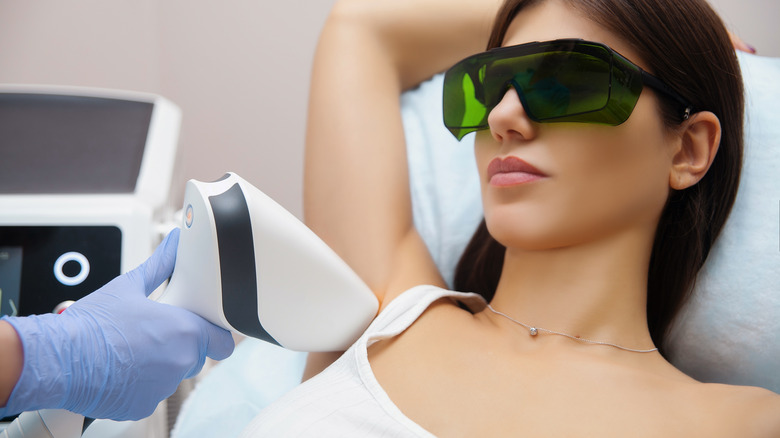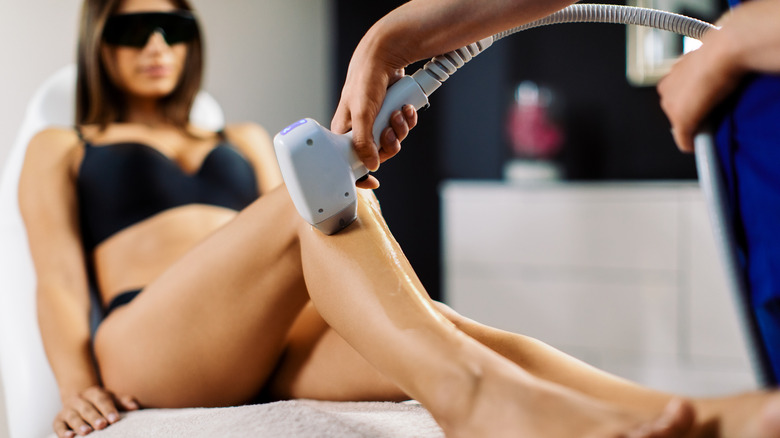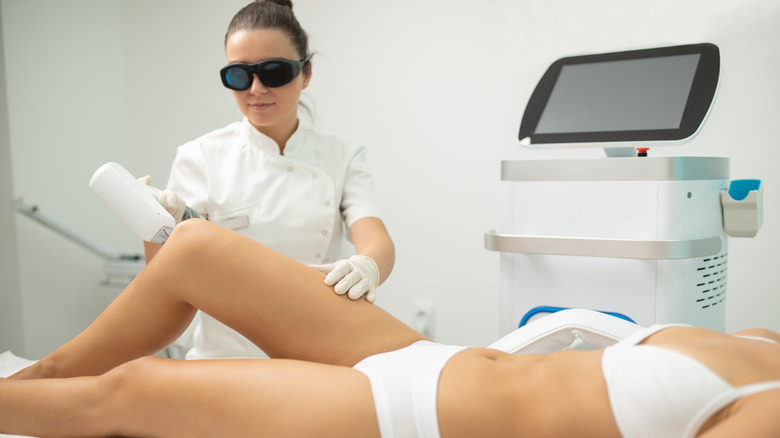How Painful Is Laser Hair Removal Really? Here's What To Know
Let's talk about hair, baby — the gift from Mother Nature that keeps on giving. And we're not talking about the luscious mane on our heads, but the hair that sprouts up on our bodies. While we strive to grow thicker, fuller hair on our coiffures, many of us strive to remove any signs of them virtually everywhere else on our bodies (and if you don't, that's perfectly okay!). Laser hair removal is here to save the day for folks who do prefer to be hair-free, without the recurring inconveniences of waxing or shaving.
"Laser hair removal works by sending light at a specific wavelength that targets melanin, the pigment that colors hair, at a depth sufficient to act on the hair bulb," board-certified dermatologist Rachel Westbay (formerly Maiman) tells Byrdie. "The intended outcome, hair removal, results from thermal injury to the hair bulb produced when the energy in the light is absorbed by the pigment located there." This sounds promising, but what about the pain? Ultimately, the discomfort factor depends on each person's pain tolerance threshold and, of course, the areas you are getting the laser treatment on. Laser hair removal on sensitive areas might feel painful for some, while the pain in other areas might be mild or even non-existent.
While the process can be painful under certain circumstances, New York-based board-certified dermatologist Dr. Leonard Bernstein, M.D., assures Well+Good that it doesn't actually cause any damage: "You're exposing the targeted hair follicle to a high energy beam of light without injuring the surrounding skin structures." So, if you do feel pain or discomfort during your session, it's usually not indicative of an injury.
Which areas of the body are the most and least painful?
Since each person's definition of "painful" is different, it's difficult to objectively quantify exactly how painful laser hair removal is. In a YouTube video for the American Academy of Dermatology, board-certified dermatologist Dr. Carolyn I. Jacob describes how the treatment feels. "The first treatment that you have, you are going to feel the most from the laser," she explains. "It's gonna feel a little bit like a light rubber band snapping against your skin."
However, that sensation may be more or less intense depending on the area being lasered. Think of it this way: Imagine pinching the skin on your shins and then pinching the skin on your underarms while applying the exact same pressure. It shouldn't hurt equally because the skin on our shins is thicker than the skin on our underarms. The same principle applies to getting a laser treatment; certain areas — particularly those with thinner skin or with a higher density of hair — hurt more than others.
So, which areas should you expect to hurt more? Sensitive areas such as your bikini line, inner thighs, and underarms are amongst the most painful. On the other hand, areas with thicker skin, such as your stomach, legs, and arms, are likely to not hurt as much. When it comes to the face, you can expect the laser to be more painful when targeting the hair on the upper lip and milder when targeting the hair around the forehead, chin, and cheeks.
How effective is laser hair removal?
Although laser hair removal is not permanent, you can expect the hair on your body to decrease significantly. "With each successive treatment, you are going to have fewer hairs, and we have found that after five treatments, we have reduced the hair by about 90 or 95%," Dr. Carolyn I. Jacob confirms in the YouTube video.
General laser hair removal typically works best on those with a contrast between skin and hair color. If you have blond or gray hair, we have bad news for you. As aesthetic nurse practitioner Nicole Frontera explains, "[Light-haired people] are not a candidate for laser hair removal because they don't have pigment in their hair, and the laser needs pigment to carry the heat down to the follicle. Brunettes or darker brown hair are best. Light brown isn't as good. The best candidates are dark hair with light skin," (via Well+Good). Board-certified dermatologist Dr. Michelle Henry explains to The Cut that laser works on melanated skin, but emphasizes that it may take more sessions to achieve the desired result: "I do find in my patients of color that I'm often doing more like eight to 10 sessions and in my other patients, they may be doing six to eight."
You can expect to get the most out of your laser hair treatment in areas where the hair is naturally coarser and darker. "Areas that respond best are underarms and the bikini area," Frontera says. "Because, in general, even if you have lighter skin, those areas will have darker, more coarse hair, which makes those lasers more efficient. Arms or upper thighs, where hair is finer, may grow back or not respond 100% to the lasers."


